Editor’s Note: This update reflects only a small part of the huge economic impact of the COVID-19 pandemic, which caused millions of layoffs and shut down much of the economy before many of these statistics were collected.
Summary
Since Donald Trump took office as president, but mostly before the COVID-19 emergency:
- The economy grew more slowly than Trump promised, most recently at 2.3% last year.
- Nearly 6.2 million jobs were added — just before nearly 17 million workers filed for unemployment insurance.
- The federal debt grew $3.8 trillion larger; annual deficits accelerated.
- Carbon dioxide emissions fell 0.6% while 1,100 coal-mining jobs were lost.
- Paychecks grew 3.4% after inflation.
- The number of people lacking health insurance rose by nearly 2 million.
- Crime decreased; handgun production fell 18.5%.
- Trump appointees filled nearly 29% of all federal appeals court judgeships.
- U.S. oil production rose 38.9%; the nation at last began pumping more oil that it consumed.
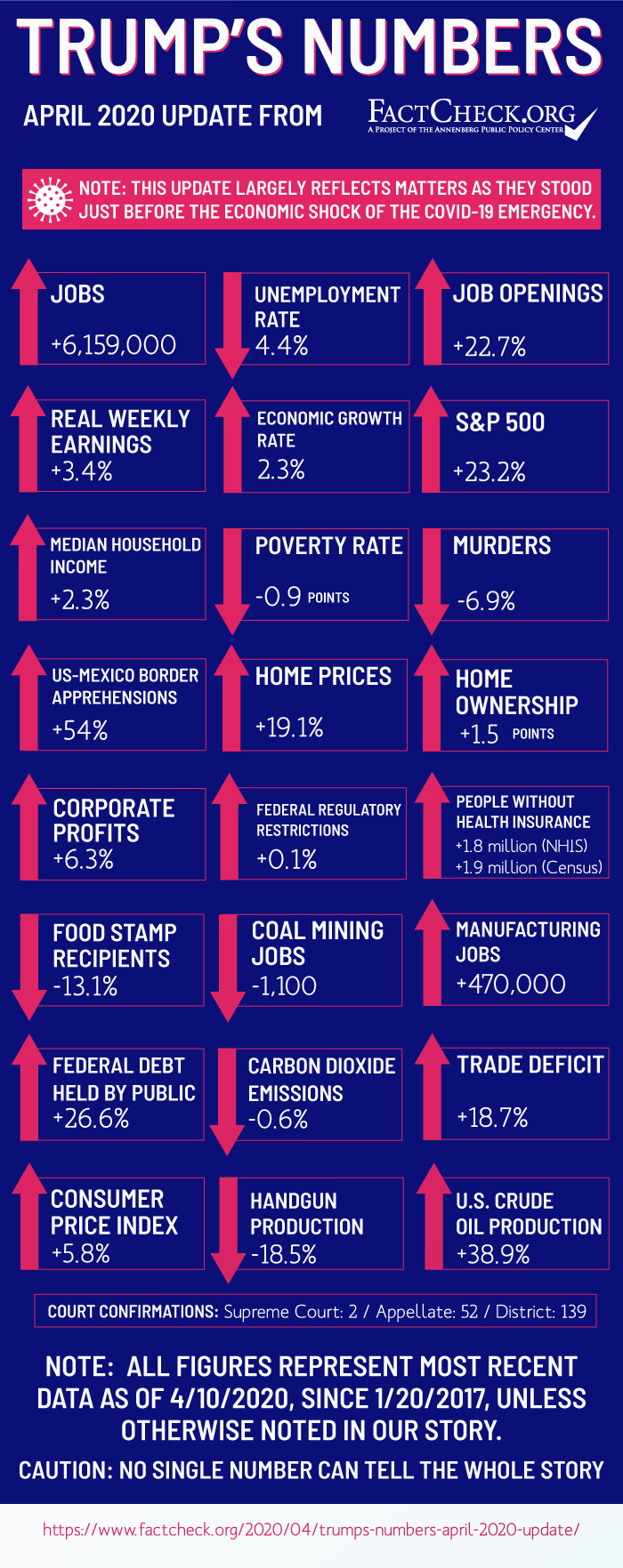
Analysis
This is our ninth quarterly update of the “Trump’s Numbers” scorecard that we posted in January 2018 and have updated every three months, most recently on Jan. 20. We’ll publish additional updates every three months, as fresh statistics become available.
Here we’ve included statistics that may seem good or bad or just neutral, depending on the reader’s point of view. That’s the way we did it when we posted our first “Obama’s Numbers” article more than seven years ago — and in the quarterly updates and final summary that followed. And we’ve maintained the same practice under Trump.
Then as now, we make no judgment as to how much credit or blame any president deserves for things that happen during his time in office. Opinions differ on that.
Jobs and Unemployment
Job growth slowed a bit under Trump — then sharply reversed as the COVID-19 crisis led to mass unemployment.
Employment — Jobs are now being lost by the millions as businesses shut down to slow the spread of the new coronavirus.
Only the first jolt from this ongoing economic cataclysm is captured in the most recent employment figures from the Bureau of Labor Statistics, however. They show that after nine years and five months of constant monthly gains, 701,000 jobs disappeared between mid-February and mid-March, the period covered by the report.
As of that latest report, a total of 6,159,000 jobs had been added since Trump took office, an increase of 4.2%.
But all those gains are certain to be wiped out in the next monthly employment report due to be published May 8. Since the period covered by the most recent report, which covered people on payrolls as of March 12, a total of nearly 16.8 million workers filed new claims for unemployment insurance in the three weeks ending April 4.
Even in February, when employment was at its highest, Trump was far behind the pace needed to fulfill his campaign boast that he would be “the greatest jobs president that God ever created.” Up until then, the average monthly gain under Trump had been 185,000, while the average monthly gain during the four years before he took office was 216,000.
Unemployment — The unemployment rate is on the rise again after falling at times to the lowest rate in nearly half a century.
The Bureau of Labor Statistics puts the rate at 4.7% when he was sworn in — well below the historical norm of 5.6%, which was the median monthly rate from 1948 to the start of Trump’s term.
The most recent rate, as of mid-March, was 4.4%.
In February it had been 3.5%, and was also at that level in September, November and December last year. Before then, it had not been so low since December 1969 — 50 years earlier — when it was also 3.5%.
There is no question that the next report will show a much higher rate. The Congressional Budget Office, for one, predicted the rate would top 10% in the second quarter of 2020.
Job Openings — Before the COVID-19 shock, a shortage of qualified workers was holding back hiring.
As of the last business day of February, the most recent figure on record, the number of unfilled job openings stood at 6.8 million. At that point the number had grown 1.3 million — or 22.7% — since Trump took office.
The number has been as high as 7.5 million as recently as January 2019, which was the highest in the 19 years the BLS has tracked this figure.
The number of unfilled jobs has exceeded the number of unemployed people looking for work every month since March 2018. In late February — two weeks before the White House declared a COVID-19 emergency — there were nearly 1.1 million more job openings than there were people seeking jobs.
Labor Force Participation — The labor force participation rate — which went down 2.9 percentage points during the Obama years — slipped a bit further under Trump.
The labor force participation rate is the portion of the entire civilian population age 16 and older that is either employed or currently looking for work in the last four weeks. Republicans often criticized Obama for the decline during his time, even though it was due mostly to the post-World War II baby boomers reaching retirement age, and other demographic factors beyond the control of any president.
The rate stood at 62.8% when Trump took office, and in February that rate had climbed to 63.4%, a gain of 0.6 percentage point. But all that was lost in March as the COVID-19 emergency caused many to simply leave the workforce entirely, and the rate dropped to 62.7%, or 0.1 percentage point below the rate Trump inherited.
Manufacturing Jobs — Manufacturing jobs increased since Trump took office, but had begun to decline even before the virus crisis began to force a wave of plant closings.
Overall, the number was up by 470,000 under Trump as of the latest report, covering pay periods that included March 12. That followed a net decrease of 192,000 under Obama.
But that’s down a bit from the peak gain of 499,000, as of mid-November last year. And the number of manufacturing jobs in March was still 907,000 below where it was in December 2007, at the start of the Great Recession.
Economic Growth
Before the COVID-19 pandemic, the U.S. economy was growing a bit faster under Trump — but not nearly as fast as he promised.
Real (inflation-adjusted) gross domestic product grew 2.3% last year. During all of Trump’s first three years the economy grew 0.6% more than in the three years just before he took office.
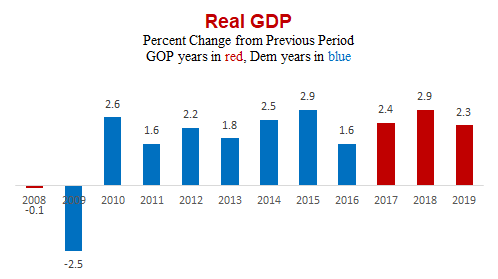

Even before the COVID-19 outbreak, growth under Trump had averaged far less than the 4% to 6% per year that he promised repeatedly, both when he was a candidate and also as president. The best annual growth achieved during Trump’s time was 2.9% in 2018 — no better than the 2.9% growth in 2015, the best year during Obama’s time.
Now there’s general agreement that growth halted — and the economy started shrinking — in February, as government officials ordered thousands of business closings to slow the spread of the deadly new coronavirus. International Monetary Fund chief Kristalina Georgieva, for one, said April 3 that the world economy had come to “a standstill” for the first time since the IMF was created in 1945, and added: “It is way worse than the global financial crisis” of 2008-2009.
But the first official estimate of real GDP growth in the first three months of 2020 won’t be released until April 29.
Income and Poverty
Household Income — Household income has risen briskly during the Trump administration.
The Census Bureau’s measure of median household income reached $63,179 in 2018, an increase of $1,400 from 2016 after adjusting for inflation.
In percentage terms, the increase during Trump’s first two years is 2.3%. (The median figure represents the midpoint — half of all households earned more, half less.)
The official figure is the highest ever recorded, exceeding previous records set in 2016 and 2017. But Census officials said those recent “records” are all due in part to a change in the survey questions in 2014. Starting then, the annual survey has picked up some sources of income that were previously missed.
Adjusting for that factor, and also for a change in the way Census processed data starting last year, Census officials published “estimated adjusted” figures showing what median household income would have been for past years, had the current questionnaire and processing procedures been in place. On that basis, the latest figure is just a few dollars less than it was in 1999 — $63,231.
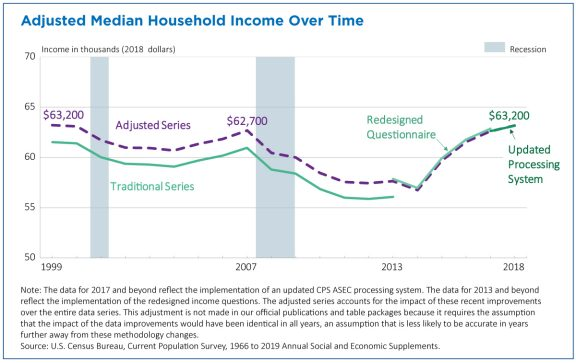
The “estimated adjusted” figures also show an even greater increase during Trump’s first two years than the official figures, because the new data processing procedures had the effect of holding down income by a fraction of a percentage point. On an adjusted basis, the increase under Trump would be $1,638, or 2.7%.
Poverty — As incomes rose, the rate of poverty declined. The percentage of Americans living with income below the official poverty line went down to 11.8% of the population in 2018, the lowest level since 2001.
The poverty rate has now declined for four consecutive years, dropping by 1.3 percentage points in 2015, by 0.8 points in 2016 and by 0.4 points and 0.5 points in Trump’s first two years.
Regulations
The growth of federal regulation has stopped under Trump.
The number of restrictive words and phrases (such as “shall,” “prohibited” or “may not”) contained in the Code of Federal Regulations stayed below 1.08 million for most of last year — a little below where it was when Trump took office. As of April 3, the count had crept up to a little above 1.08 million — an increase of 1,286 (or 0.1%) since Trump’s inauguration.
That the number has barely changed is a big departure from the past, when restrictions grew at an average of 1.5% per year during both the Obama years and the George W. Bush years, according to annual QuantGov tracking.
The Mercatus count of restrictions doesn’t attempt to assess the cost or benefit of any particular rule — such assessments require a degree of guesswork and are sensitive to assumptions. But it does track the sheer volume of federal rules with more precision than we have found in other metrics.
Some of the recent changes are just clearing deadwood. In 2018, for example, the Treasury Department scrapped an entire chapter of zombie-like regulations issued by the old Office of Thrift Supervision, which oversaw the savings-and-loan industry before being abolished in 2011. S&Ls have since fallen under other federal banking regulators, but the obsolete OTS rules remained on the books.
However, many of the rules Trump has eliminated are quite significant. For example, in what it called “the largest deregulatory initiative of this administration,” it issued a final rule that nullifies Obama-era fuel economy standards for new cars and light trucks. The administration said that instead of commanding automakers to achieve average mileage of 46.7 miles per gallon by the year 2025, the Trump rule will require them to achieve only an average of 40.4 mpg.
Another example: Last September, the EPA’s Affordable Clean Energy rule took effect, repealing the Obama administration’s Clean Power Plan rule. The Obama-era rule was designed to reduce carbon dioxide emissions by shifting away from coal as an energy source and would have required states to meet specific emissions reductions.
Crime
Crime declined since Trump took office.
The FBI’s annual Crime in the United States report, released Sept. 30, showed the number of murders declined 6.9% during Trump’s first two years in office.
And the decline continued into the first half of last, according to the FBI’s preliminary semiannual report released Jan. 21. The FBI tallied 3.9% fewer murders during the first half of 2019 than in the same period in 2018.
The murder rate per 100,000 people went down to 5.0 in 2018, still well above the record low set in 2014, when it was 4.4. The FBI doesn’t calculate rates in its semiannual reports, so the rate for 2019 won’t be known until full-year figures are released, which usually happens in September.
As a candidate, Trump repeatedly claimed that the murder rate was “the highest it’s been in 45 years.” That was far from true. The rate did rise during Obama’s final two years, to 5.4 per 100,000 in 2016. But the highest rate in the past half century was 10.2 in 1980.
The number of violent crimes (murder, rape, robbery and aggravated assault) went down 3.5% between 2016 and 2018, and dropped another 3.1% in the first six months of 2019, compared with the same period a year earlier.
The number of property crimes (burglary, larceny and motor vehicle theft) went down 9.2% during Trump’s first two years, and declined another 5.6% in the first half of last year, compared to the same six months a year earlier.
Guns
Sales and production of guns pulled back since Trump became president, after surging to record levels during the Obama years.
Handgun Production — In 2018, annual production of pistols and revolvers in the U.S. totaled over 4.5 million, according to final figures from the Bureau of Alcohol, Tobacco, Firearms and Explosives.
That represented a decline of 18.5% from 2016, when production surged to a record level of nearly 5.6 million.
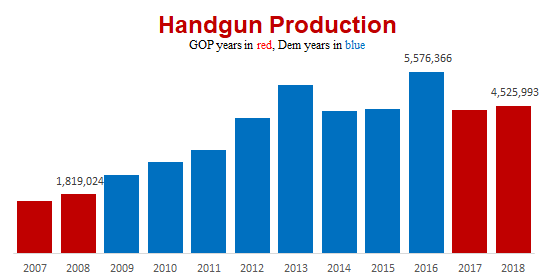
Handgun production more than tripled during the Obama years. So the 2018 level was still 150% higher than it had been in 2008, the last year of George W. Bush’s presidency.
Gun Sales — Gun sales also dropped a little — but, recently, COVID-19 concerns set off a new wave of buying.
The government doesn’t collect figures on sales of guns. But the National Shooting Sports Foundation — the gun industry’s trade group — tracks approximate sales figures by adjusting FBI statistics on background checks to remove those not related to actual sales, such as checks required for concealed-carry permits.
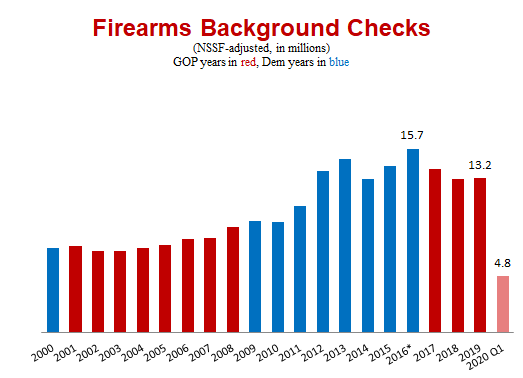
Those NSSF-adjusted figures dropped from a record 15.7 million in Obama’s final year to 14.6 million during the most recent 12 months ending in March — a decrease of 6.8%.
But people were flocking to gun stores during the first three months of this year, when adjusted background checks hit 4.8 million, a rise of 42% compared with the same period a year earlier. March alone saw an 80% increase over the same month in 2019. Numerous news accounts attributed the rush to buy guns to fears that the spread of the coronavirus would lead to social unrest.
These figures cover rifles and shotguns and previously owned weapons, as well as new handguns. They are only an approximation of actual sales, since some of these checks cover purchases of multiple weapons, and of course some sales still occur without background checks.
Coal and Environment
Coal Mining Jobs — As a candidate, Trump promised to “put our [coal] miners back to work,” but he hasn’t.
As of March, there were 1,100 fewer coal mining jobs than when Trump took office, according to BLS figures. That’s a decline of 2.2%.
The coronavirus pandemic may have hastened some of the losses, but, in fact, nearly 600 mining jobs were lost as early as September — long before the virus appeared in China — when two Wyoming mines closed and the owner filed for bankruptcy protection. And Moody’s Investor Services said it had been predicting a 15% to 20% decline in U.S. coal production this year even before the virus hit.
U.S. coal production last year was the lowest in 41 years. During the 12 months ending in February (the most recent month for which figures are available), the Energy Information Administration estimated that 685 million short tons were produced, which is 5.9% below the figure for 2016.
The outlook for coal miners has gotten even more bleak since our last report. In April, EIA predicted that coal production would fall 22% in 2020, in part due to coal mines closed by the COVID-19 disease, and lower demand for coal-generated electricity during a virus-induced world economic slump.
Carbon Emissions — Carbon dioxide emissions from energy consumption declined under Trump, continuing a long downward trend that started years before he took office.
Figures from EIA show CO2 emissions were 0.6% lower in 2019 than they were in 2016.
In the decade before Trump took office, emissions fell by a total of 14%, due mainly to electric utilities shifting away from coal-fired plants in favor of cheaper, cleaner natural gas, as well as solar and wind power. Under Trump, the trend reversed with a temporary 2.9% increase in 2018.
But that year was an anomaly. A hotter than normal summer and colder than normal winter resulted in higher natural gas consumption. And an even bigger anomaly is predicted this year — in the opposite direction.
EIA is currently estimating that CO2 emissions fell 2.7% in 2019, and predicted they “will decrease by 7.5% in 2020 as the result of the slowing economy and restrictions on business and travel activity related to COVID-19.”
Border Security
Illegal border crossings have subsided after surging last year to the highest in a dozen years. But they are still running higher under Trump than before he took office.
Last year, a monthly average of 66,400 people were apprehended attempting to illegally enter the U.S. at the border with Mexico, the highest level since 2007.
The peak month was May, which saw 132,856 apprehensions, according to U.S. Customs and Border Protection statistics. That was the highest total since March 2006, when the monthly total hit nearly 161,000.
During the first three months of 2020, the average has gone down to 29,743 per month.
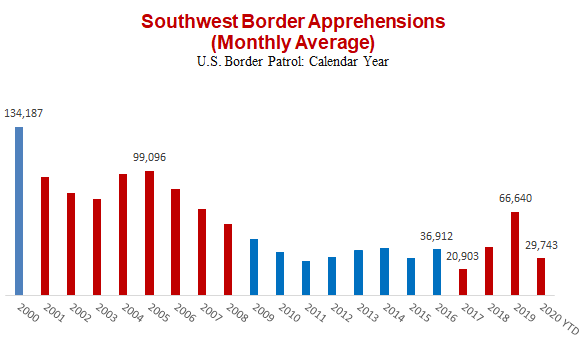
Attempted border crossings tend to be highest in March, April and May and lowest in December. So to even out that seasonal factor, our measure compares the most recent 12 months on record with the year prior to a president taking office. And for the past 12 months, apprehensions totaled 681,209, an increase of 53.8% over 2016, when the total was 442,940.
Another way to take seasonality into account is to compare the most recent three months with the same period in 2016. By that measure, which ignores the worst of last year’s surge, apprehensions in January, February and March of this year were still 7.3% higher than in the same months of 2016.
Corporate Profits
After-tax corporate profits remained near record levels during Trump’s presidency. During 2019, they hit $1.85 trillion for the year (see line 45), just under the record $1.86 trillion recorded for 2014.
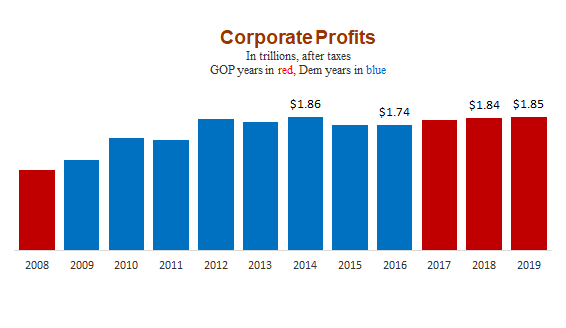
The most recent year’s figure is 6.3% higher than the full-year figure for 2016, the year before Trump’s inauguration.
Stock Market
The stock market topped a decade-long bull market with new records in early 2020 — until the bottom dropped out in March as the COVID-19 emergency forced businesses to close and lay off millions of workers.
After weeks of wild swings up and down (mostly down) roughly half the gains of the Trump years were erased.
The Standard & Poor’s 500-stock average closed most recently on April 9 at 23.2% above where it has been the day before Trump was inaugurated. At our previous update three months ago the gain had been 47.1%
Other indexes took similar rides. At the April 9 close, the Dow Jones Industrial Average, made up of 30 large corporations, was up 20.2% during Trump’s time in office. As of our January update it had been up 48.7%.
And the NASDAQ composite index, made up of more than 3,000 companies, was up 47.2% under Trump on April 10, compared with a 69.5% gain at our January update.
Wages and Inflation
The upward trend in real wages continued under Trump, and inflation remained in check.
CPI — The Consumer Price Index rose 5.8% during Trump’s first 38 months, continuing a long period of historically low inflation.
In the most recent 12 months, ending in March, the CPI rose only 1.5% — held down in part by a recent plunge in gasoline prices. The CPI rose an average of 1.8% each year of the Obama presidency (measured as the 12-month change ending each January), and an average of 2.4% during each of the George W. Bush years.
Wages — Paychecks continued to grow faster than prices.
The average weekly earnings of all private-sector workers, in “real” (inflation-adjusted) terms, rose 3.4% during Trump’s first 38 months (ending in March).
Those figures include managers and supervisors. Rank-and-file production and nonsupervisory workers (82% of all workers) are doing just a bit better than their bosses. Real earnings for them have gone up 3.8% so far under Trump.
Those gains extend a long trend. Real wages took a dive during the Great Recession of 2007-2009, but have been rising now since hitting a low point in July 2008. During the Obama years, real weekly earnings rose 4.1% for all workers, and 4.2% for rank-and-file.
Consumer Sentiment
Consumer confidence in the economy, which at first rose under Trump, plunged to the lowest point in 19 years when the COVID-19 emergency hit.
The University of Michigan’s Surveys of Consumers monthly index first soared to a peak of 101.4 in March 2018, which was the highest in 14 years. It was still at 101.0 as recently as February.
But in March and early April, it took the worst plunge ever recorded, to a preliminary figure of 71.0. That was the lowest since December 2011, when the nation was struggling to recover from the Great Recession of 2007-2009.
Even so, the survey’s chief economist, Richard Curtin, said consumers may still be too optimistic. “Sharp additional declines may occur when consumers adjust their views to a slower expected pace of the economic recovery,” he wrote.
The preliminary April figure, released April 9, was 16.2 points below where it was in October 2016, just before Trump was elected after promising to boost economic growth.
Home Prices and Ownership
Home Prices — Home prices soared to record levels during Trump’s tenure.
The national median price of an existing, single-family home set a record high of $288,500 in June 2019, according to sales figures from the National Association of Realtors.
Prices have moderated a bit since then, but still stood at $272,400 in February, the most recent monthly figure available. That is $43,700 higher than the median price of $228,700 for homes sold during the month Trump took office — a gain in value of 19.1%. The rise in the Consumer Price Index during the same period was 6.3%.
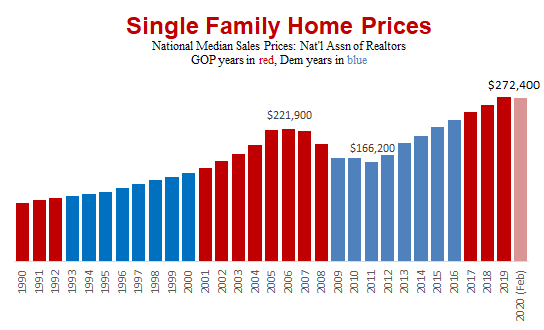
The Realtors’ figures reflect raw sales prices without attempting to adjust for such factors as variations in the size, location, age or condition of the homes sold in a given month or year. Even so, a similar pattern emerges from the S&P CoreLogic Case-Shiller U.S. National Home Price Index, which compares sales prices of similar homes and seeks to measure changes in the total value of all existing single-family housing stock.
The Case-Shiller index for January sales (the most recent available) was at a record high — and 15.0% above where it stood in the month Trump took office.
Whichever way you measure it, homeowners have seen the value of their houses rise substantially since Trump became president.
Homeownership — The percentage of Americans who own their homes has continued to recover under Trump.
Back in 2004, the homeownership rate hit a record 69.2% of households for two quarters, but then began a years-long slide, hitting bottom in the second quarter of 2016 at 62.9%. That was the lowest point in more than half a century, and tied for the lowest on record.
The rate recovered 0.8 points in the six months before Trump took office, and has gone up another 1.5 points since then, reaching 65.1% in the fourth quarter of last year, the most recent Census Bureau figure available.
But that’s still 4.1 points below the peak level of 15 years earlier.
Trade
The trade deficit that Trump promised to reduce grew larger instead, but now is headed down.
The most recent government figures show that the total U.S. trade deficit in goods and services during the most recent 12 months on record (ending in February) was just under $597 billion, an increase of 18.7% over the deficit for 2016.
However, the deficit stabilized last year, falling 1.8% in 2019 after rising 12.4% in 2018 and 8.6% in 2017, Trump’s first year in office.
The decline in the deficit has accelerated since our last report, falling 12.2% in February alone. That’s partly due to the new coronavirus that emerged in China in December, leading to massive disruption of China’s production and a big drop in U.S. imports of Chinese goods.
China — The goods-and-services trade deficit with China has finally grown a tiny bit smaller under Trump.
Trump began a full-scale trade conflict with China in early 2018. At first the trade gap with China continued to go up, but that turned around in 2019. Last year, the goods-and-services trade deficit with China was 0.4% less than in 2016, the latest figures show.
The trade war continues. Trump signed a “phase one” trade deal with China on Jan. 15, under which the U.S. held off on new tariffs while China promised to buy more U.S. agricultural goods. But the big issues aren’t settled. China has yet to agree to reduce subsidies to exporting businesses or to limit its demands that U.S. businesses share their intellectual property.
Mexico — Meanwhile the much smaller trade deficit in goods and services with Mexico has grown much faster than the global trade gap. It totaled $101 billion during 2019, an increase of 63% compared with 2016.
Canada — The trade surplus that the U.S. runs with Canada has turned into a deficit. In 2016, the U.S. sold nearly $7.5 billion more to Canada in goods and services than it bought from the U.S. That flipped last year, when the U.S. imported $5.3 billion more from Canada than the other way around.
On March 13, Canada gave final legislative approval of a new trade agreement with the U.S. and Mexico, to replace the 26-year-old North American Free Trade Agreement, which Trump had promised to scrap during his campaign. The new agreement will be called the United States-Mexico-Canada Agreement, or USMCA. It will take effect after all three countries work out implementing regulations.
Health Insurance Coverage
The number of people lacking health insurance rose by nearly 2 million under Trump.
The Census Bureau reported Sept. 10 that the number of Americans who lacked health insurance for all of 2018 was 27.5 million — up from 25.6 million in 2017. That’s an increase of 1.9 million.
It was the first time in a decade that this number increased. The percentage of Americans without coverage for the entire year rose to 8.5%, from 7.9% the year before.
(A technical note: Normally we would compare the most recent figures with those from 2016, before Trump took office. But last year Census used a new “improved” method to estimate the uninsured population in 2017 and 2018, and said these figures shouldn’t be compared with estimates produced in earlier years.)
The Census report confirmed a trend we’ve been tracking using a somewhat different measure released on a more frequent and timely basis by the National Health Interview Survey. The NHIS put the number of people who lacked coverage at the time they were interviewed — not necessarily for the entire year — at 30.4 million in 2018, an increase of 1.8 million over 2016.
The NHIS said 9.4% of the population lacked coverage at the time of interview in 2018, up from 9% in 2016.
A much greater rise was reported by a Gallup survey covering the final quarter of 2018. Gallup, on Jan. 23, 2019, put the rise in uninsured adults at about 7 million, compared with the last half of 2016. Gallup put the percentage of uninsured adults at 13.7% in the October-December quarter. For details, see our Feb. 12 story, “Did the Uninsured Increase by 7 Million?“
Trump failed to “repeal and replace” the Affordable Care Act as he promised to do, but did slash advertising and outreach aimed at enrolling people in Obamacare plans. In December 2017, he signed a tax bill that ended the ACA’s tax penalty for people who fail to obtain coverage, effective last year. In March 2019, the Trump administration joined an effort by GOP state attorneys general seeking a court decision to overturn the entire act. On March 2 the Supreme Court agreed to hear the case, and could hear arguments on it later this year.
Food Stamps
The number of food stamp recipients dropped to the lowest levels in a decade.
Early last year, the number dropped below 38 million for the first time since October 2009, when millions were signing up for benefits in the aftermath of the Great Recession of 2007-2009.
As of January, the most recent month for which figures are available, 37.1 million people were receiving the aid.
The number of food stamp recipients has gone down 5.6 million, or 13.1%, since January 2017, when Trump took office.
The number of recipients is now 10.7 million below the peak month of December 2012. But it is still 9.7 million above where it was at the start of the Great Recession, in December 2007, despite years of an improving economy.
Before millions were thrown out of work due to the COVID-19 pandemic, the administration was working to reduce the number further. On April 1 a new rule would have taken effect tightening work requirements for able-bodied adults without dependents. That would have caused 688,000 fewer people to be eligible for benefits in the fiscal year that begins Oct. 1, according to the Department of Agriculture’s regulatory analysis.
But on March 18 the president signed a bipartisan emergency relief bill that (among other things) both suspended the new work requirement rule temporarily and also made families eligible for food stamps if their children had received free or reduced cost meals at schools that are now closed.
And last July, the Trump administration proposed another rule that it said could remove another 3 million people from the rolls. That rule would take away flexibility that many states now use to grant food aid to people with income or assets exceeding federal limits.
Judiciary Appointments
Trump is putting his mark on the federal appeals courts more quickly than Obama was able to do in his time in office.
Supreme Court — So far, Trump has won Senate confirmation for two Supreme Court nominees, Justice Neil M. Gorsuch and Justice Brett M. Kavanaugh.
Obama also was able to fill two high court vacancies during his first two years in office, with Justice Sonia Sotomayor and Justice Elena Kagan.
Court of Appeals — Trump also won confirmation of 52 U.S. Court of Appeals judges (30 during his first two years and another 22 in 2019 and so far in 2020). That’s nearly double the total for Obama, who won confirmation for 27 as of the same point in his first term (16 during his first two years and 11 more in 2011 and early 2012).
Trump has now installed 29% of all the 179 appellate court judges authorized by federal law.
District Court — Trump also outpaced Obama on filling lower courts. So far, Trump has won confirmation for 139 of his nominees to be federal District Court judges. That’s nearly 21% of the 677 authorized district judges. Obama had won confirmation for 111 at the same point in his presidency.
Trump also has filled five seats on the U.S. Court of Federal Claims, which has nationwide jurisdiction over lawsuits seeking money from the government. And he has filled two seats on the U.S. Court for International Trade. Obama filled none to either court during his first term.
Trump must share responsibility for this record with the Republican majority in the Senate. Republicans not only refused to consider Obama’s appointment of Merrick Garland to fill the Supreme Court vacancy eventually filled by Gorsuch, but they also blocked confirmation of dozens of Obama’s nominees to lower courts. Trump inherited 17 Court of Appeals vacancies, for example, including seven that had Obama nominees pending but never confirmed.
Federal Debt and Deficits
The federal debt has increased by $3.8 trillion under Trump. And the rise is accelerating as the government borrows frantically to fund emergency COVID-19 spending.
The federal debt held by the public stood at just over $18.2 trillion at the last count on April 9 — 26.6% higher than on the day he took office.
The figure likely will continue to surge at an unprecedented rate in months to come as tax revenues fall due to the shutdown of the economy, and spending ramps up to aid jobless workers and shuttered businesses.
But even before the COVID-19 emergency, Trump’s cuts in corporate and individual income tax rates — as well as bipartisan spending deals he signed in 2018 and 2019 — caused the red ink to gush even faster than it did before.
The federal government’s annual deficit hit $984 billion in fiscal year 2019, which ended Sept. 30 last year.
CBO’s most recent budget projections, issued March 19, estimated that annual deficits would be nearly $1.1 trillion in the current fiscal year and grow to nearly $1.8 trillion in fiscal 2030. But that didn’t account for trillions in new spending Congress has since approved to meet the coronavirus emergency. The nonpartisan Committee for a Responsible Federal Budget estimated that “actual deficits could ultimately end up being twice as high” as CBO estimated.
The debt at the end of 2019 was equal to about 79% of the nation’s entire gross domestic product. CBO said March 12 that the debt was already on track to hit 98% of GDP by 2030, and now it’s sure to rise even faster.
Oil Production and Imports
U.S. crude oil production resumed its upward trend under Trump, hitting record levels. Production topped 4 billion barrels in 2018 for the first time on record, and kept on rising. In the 12 months ending in January (the most recent data available) it reached just under 4.5 billion barrels. That was 38.9% higher than in all of 2016.
With production surging, the nation’s dependence on imported petroleum at last disappeared. EIA figures show the U.S. became a net exporter last September, and in every month since. During the first two months of 2020 the exported surplus in crude oil and petroleum products amounted to 2.4% of domestic consumption, EIA estimated.
Dependence on foreign oil peaked in 2005, when the U.S. imported 60.3% of its petroleum.
Sources
Bureau of Labor Statistics. “Employment, Hours, and Earnings from the Current Employment Statistics survey (National); Total Nonfarm Employment, Seasonally Adjusted.” Data extracted 10 Apr 2020.
Bureau of Labor Statistics. “Labor Force Statistics from the Current Population Survey; Unemployment Rate, Seasonally Adjusted.” Data extracted 10 Apr 2020.
Swagel, Phil “Updating CBO’s Economic Forecast to Account for the Pandemic” Congressional Budget Office. 2 Apr 2020.
Bureau of Labor Statistics. “Job Openings and Labor Turnover Survey: Job Openings, Seasonally Adjusted.” Data extracted 10 Apr 2020.
Bureau of Labor Statistics. “Labor Force Statistics from the Current Population Survey; Labor Force Participation Rate.” Data extracted 10 Apr 2020.
Bureau of Labor Statistics. “Labor Force Statistics from the Current Population Survey; Unemployment Level, Seasonally Adjusted.” Data extracted 10 Apr 2020.
Bureau of Labor Statistics. “Labor Force Statistics from the Current Population Survey; All employees, thousands, manufacturing, seasonally adjusted.” Data extracted 10 Apr 2020.
U.S. Bureau of Economic Analysis. “Table 1.1.1. Percent Change From Preceding Period in Real Gross Domestic Product.” Interactive data extracted 4 Oct 2019.
CNBC “Coronavirus pandemic economic fallout ‘way worse than the global financial crisis,’ IMF chief says” 3 Apr 2020.
U.S. Census Bureau. “Current Population Survey, 1966 to 2019 Annual Social and Economic Supplements.” 10 Sep 2019.
McLaughlin, Patrick A., and Oliver Sherouse. RegData US 3.1 Daily (dataset). QuantGov, Mercatus Center at George Mason University, Arlington, VA. Daily Summary tracking of restrictions in the eCFR (Electronic Code of Federal Regulations). Also RegData U.S. Regulation Tracker. Downloaded 10 Apr 2020.
McLaughlin, Patrick A. and Oliver Sherouse. RegData US 3.1 Annual (dataset). QuantGov, Mercatus Center at George Mason University, Arlington, VA.. “RegData 3.1 Annual Summary.” Downloaded 10 Apr 2020.
Federal Bureau of Investigation. “Crime in the United States 2018,” Table 1. 30 Sep 2019.
Federal Bureau of Investigation. “Preliminary Semiannual Uniform Crime Report, January–June, 2019.” 21 Jan 2020.
U.S. Bureau of Alcohol, Tobacco, Firearms and Explosives. “Annual Firearms Manufacturing and Export Report, Year 2018 Final.” 1 Jan 2020.
U.S. Bureau of Alcohol, Tobacco, Firearms and Explosives. “Annual Firearms Manufacturing and Export Report, Year 2016 Final.” 4 Jan 2018.
U.S. Bureau of Alcohol, Tobacco, Firearms and Explosives. “Annual Firearms Manufacturing and Export Report, Year 2008 Final.” 8 Mar 2011.
National Shooting Sports Foundation. “National Shooting Sports Foundation® Report: NSSF-Adjusted NICS – Historical Monthly Chart.” Proprietary data supplied on request and posted with NSSF permission. 1 Apr 2020.
Bureau of Labor Statistics. “Labor Force Statistics from the Current Population Survey; All employees, thousands, coal mining, seasonally adjusted.” Data extracted 10 Apr 2020
U.S. Energy Information Administration. “Table 6.1 Coal Overview” Online data from Monthly Energy Review. 26 Mar 2020.
U.S. Energy Information Administration. Short Term Energy Outlook. 7 Apr 2020.
U.S. Energy Information Administration. “Monthly Energy Review: Table 11.1 Carbon Dioxide Emissions From Energy Consumption by Source.” 26 Mar 2019.
U.S. Border Patrol. “U.S. Border Patrol Southwest Border Apprehensions FY 2020.” 9 Apr 2020.
U.S. Border Patrol. “Total Illegal Alien Apprehensions By Month Fiscal Years 2000-2018.” Undated. Accessed 10 Apr 2020.
U.S. Bureau of Economic Analysis. Corporate Profits After Tax (without IVA and CCAdj) (CP), retrieved from FRED, Federal Reserve Bank of St. Louis. 10 Apr 2020
U.S. Bureau of Economic Analysis. “National Income and Products Accounts, Table 1.12. National Income by Type of Income, Annual.” 26 Mar 2020.
U.S. Bureau of Economic Analysis. “National Income and Products Accounts, Table 1.12. National Income by Type of Income, Quarterly.” 26 Mar 2020.
Egan, Matt. “The bull market turns 10 years old.” CNN Business. 11 Mar 2019.
Menton, Jessica and Nathan Bomey. “Dow endures worst day since ‘Black Monday’; S&P 500 enters bear market as coronavirus spreads economic gloom.” 12 Mar 2020.
Yahoo! Finance. “Dow Jones Industrial Average.” Accessed 10 Apr 2020.
Yahoo! Finance. “S&P 500.” Accessed 10 Apr 2020.
Yahoo! Finance. “NASDAQ Composite.” Accessed 10 Apr 2020.
Bureau of Labor Statistics. “Consumer Price Index – All Urban Consumers.” Data extracted 10 Apr 2020.
Bureau of Labor Statistics. “Employment, Hours, and Earnings from the Current Employment Statistics survey (National); Average Weekly Earnings of All Employees, 1982-1984 Dollars.” Data extracted 10 Apr 2020.
Bureau of Labor Statistics. “Employment, Hours, and Earnings from the Current Employment Statistics survey (National); Average Weekly Earnings of production and nonsupervisory employees, 1982-1984 Dollars.” Data extracted 10 Apr 2020.
University of Michigan Surveys of Consumers. “The Index of Consumer Sentiment.” 9 Apr 2020.
National Association of Realtors. “Sales Price of Existing Single-Family Homes.” 20 Mar 2020.
S&P Dow Jones Indices. “S&P CoreLogic Case-Shiller U.S. National Home Price NSA Index.” Data extracted 10 Apr 2020.
U.S. Census Bureau. “Time Series: Not Seasonally Adjusted Home Ownership Rate.” Data extracted 10 Apr 2020.
U.S. Bureau of Economic Analysis. “U.S. International Trade in Goods and Services, November 2019.” 2 Apr 2020.
U.S. Bureau of Economic Analysis. “Table 1, U.S. Trade in Goods and Services, 1992-present.” 2 Apr 2020.
U.S. Bureau of Economic Analysis. “Table 3. U.S. International Trade by Selected Countries and Areas: Balance on Goods and Services.” 2 Apr 2020.
Berchick, Edward R. et al. “Health Insurance Coverage in the United States: 2018.” U.S. Census Bureau. 10 Sep 2019.
Centers for Disease Control and Prevention; National Health Interview Survey. “Health Insurance Coverage: Estimates From the National Health Interview Survey, 2018.“ 9 May 2019.
Witters, Dan. “U.S. Uninsured Rate Rises to Four-Year High.” Gallup. 23 Jan 2019.
Kliff, Sarah. “Trump is slashing Obamacare’s advertising budget by 90%.” Vox.com. 31 Aug 2017.
Lee, MJ et al. “GOP Obamacare repeal bill fails in dramatic late-night vote.” CNN.com. 28 Jul 2017.
Mukherjee, Sy. “The GOP Tax Bill Repeals Obamacare’s Individual Mandate. Here’s What That Means for You.” Fortune. 20 Dec 2017.
Haberman, Maggie and Robert Pear. “Trump Sided With Mulvaney in Push to Nullify Health Law.” The New York Times. 27 Mar 2019.
Texas v U.S. (5th Cir. 2020)
Luthi, Susannah. “Supreme Court will hear major challenge to Obamacare” 2 Mar 2020.
U.S. Department of Agriculture, Food and Nutrition Service. “Supplemental Nutrition Assistance Program (Data as of April 10, 2020).” 10 Apr 2020.
U.S. Department of Agriculture, Food and Nutrition Service. Supplemental Nutrition Assistance Program (SNAP) data, FY 69 through FY18 National View Summary. ZIP Excel files. Accessed 10 Apr 2020.
U.S. Department of Agriculture, Food and Nutrition Service. “Regulatory Impact Analysis, 7 CFR Part 273, Supplemental Nutrition Assistance Program: Requirements for Able-Bodied Adults Without Dependents.” 5 Dec 2019.
The White House. “Bill Announcement.” 19 Mar 2020.
“Families First Coronavirus Relief Act.” Public Law 116–127. 18 Mar 2020.
Rosenbaum, Dottie et al. “USDA, States Must Act Swiftly to Deliver Food Assistance Allowed by Families First Act.” Center on Budget and Policy Priorities. 7 Apr 2020.
Reiley, Laura. “Trump proposal would push 3 million Americans off food stamps.” Washington Post. 23 Jul 2019.
Administrative Office of the U.S. Courts. “Judicial Confirmations for January 2019,” archived web listing of confirmations in 115th Congress. Accessed 10 Apr 2020.
Administrative Office of the U.S. Courts. “Confirmation Listing” web listing of confirmations in 116th Congress. Accessed 10 Apr 2020.
Administrative Office of the U.S. Courts. “Judicial Confirmations for January 2011,” archived web listing of confirmations in 110th Congress. Accessed 10 Apr 2020.
Administrative Office of the U.S. Courts. “Judicial Confirmations for January 2013,” archived web listing of confirmations in 111th Congress. Accessed 10 Apr 2020.
U.S. Treasury. “The Debt to the Penny and Who Holds It.” Data extracted 10 Apr 2020
U.S. Treasury. “Final Monthly Treasury Statement.” Oct 2019.
Congressional Budget Office. “Baseline Budget Projections as of March 6, 2020.” 19 Mar 2020.
“CBO Updates Budget Projections Before Coronavirus Impact.” Committee for a Responsible Federal Budget. 19 Mar 2020.
Congressional Budget Office. “Federal Debt: A Primer.” 12 Mar 2020.
U.S. Energy Information Administration. “U.S. Field Production of Crude Oil.” Accessed 10 Apr 2020.
U.S. Energy Information Administration. “Table 3.3a Petroleum Trade: Overview.” Monthly Energy Review. Accessed 10 Apr 2020.